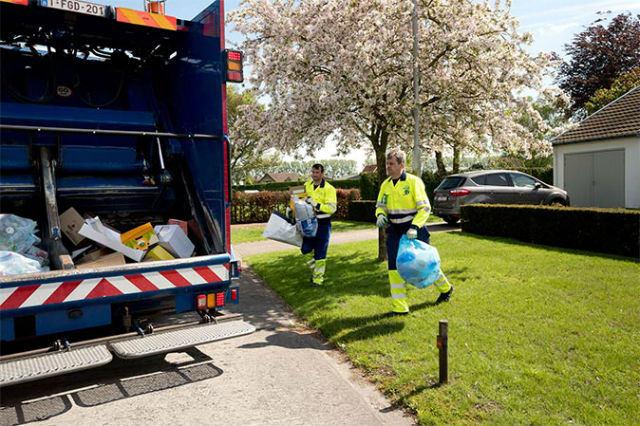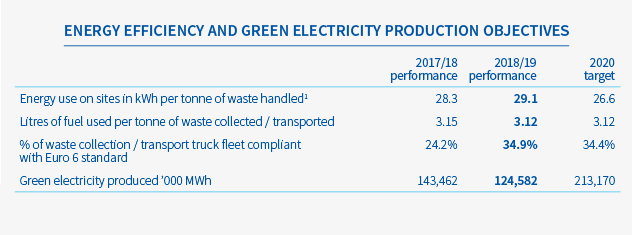Planet
Making a positive impact
We protect the environment by taking waste and creating something new. This helps to protect the world’s natural resources and to preserve the planet for future generations. Our work is integral to preserving the planet’s natural resources and it puts us at the heart of the circular economy.

Taking a precautionary approach to environmental challenges, we believe that today’s waste materials are tomorrow’s resources. That’s why we prioritise waste recycling over energy recovery or landfill disposal for all the waste we receive. Moreover, we invest in innovative technologies and business models for circular products. We keep our environmental impact and carbon footprint as low as possible and strive to maximise the carbon avoidance benefit within our value chain. We make sure our emissions to soil, water and air stay well within the legally-permitted boundaries and we measure our performance for these indicators and have set improvement targets.
We communicate with our upstream clients and encourage them to sort and segregate their wastes so that we can provide the highest sustainability benefits to society from our activities. We encourage our upstream customers to direct their wastes towards sustainable waste management options rather than to disposal. We place our downstream recycled and recovered products and green energy into markets where their sustainability benefits can be maximised. Doing so, we promote greater environmental responsibility, both within our supply chain and in society as a whole.
Recycling and recovery
Recycling and recovery rates are key indicators of our sustainability performance. We set ourselves objectives for our combined recycling and recovery rate, as well as our recycling rate. For both measures, the higher the percentage, the better our performance.
Our recycling and recovery activities also have a carbon avoidance benefit. We report this avoidance benefit in total and as an intensity ratio per tonne of waste handled. This ratio accounts for the weight of waste we handle, and tracks our performance. The higher the number, the better our performance.
In 2018/19 both our recycling and overall recycling and recovery rates continued to increase, and for our overall rate we have met our 2020 target a year early. Recycling rates rose 0.6% to 66.9%, edging closer to our 70% target, mainly as the result of improved recycling in the Netherlands and the UK. A decrease in waste to landfill in Belgium and the UK also helped us to meet our overall targets. Total waste handled reduced to 13.85 from 14.02, mainly due to a decrease in soil cleaning activities at our ATM plant in the Netherlands. However, over the past year materials recovered for energy production from waste continued to increase, from 3.19 million tonnes to 3.20 million tonnes. The long-term trend over the past 10 years shows an increase in terms of both tonnes of waste recycled and recovered as a percentage of million tonnes of waste handled.

Carbon benefit
By increasing our recycling and recovery rates, we create a positive carbon benefit. In addition, over 2018/19 we have also continued to make a positive impact on our carbon footprint by reducing our emissions. Our carbon avoidance intensity ratio rose by 1.8%, partially as the result of a small increase in recycling, but mainly due to an increase in waste-derived fuels produced and sold.
This effect counteracts a decreased carbon avoidance from waste used as a fuel at our ATM site in the Netherlands, which was caused by a drop in production at the site’s thermal cleaning installation. Over the past 10 years our long-term carbon avoidance trend, in terms of tonnes of CO2- equivalent per million tonnes of waste handled, is on an ongoing upwards trajectory.

Energy efficiency
While green electricity production reduced over the past year, largely as a result of the sale of our Energen Biogas anaerobic digestion (Cumbernauld AD) plant in the UK, green electricity production over the past ten years continues on an upwards trajectory, as measured in terms of MWh of green electricity we produce. Our green electricity production target of 213, 170 MWh for 2020 also includes the likely contribution from our new Derby plant in the future.
Our route optimisation initiatives and investment in Euro 6 waste collection vehicles during 2018/19 have helped us meet our transport energy efficiency objectives early. Truck fuel use improved by 1.1% – we used slightly more fuel but collected more waste – and so the litres of fuel used per tonne of waste collected and transported also reduced to meet our 2020 target of 3.12 litres of fuel per tonne of waste collected. We expect our fuel efficiency rates to improve further over the coming year. With Euro 6 vehicles now accounting for 34.9% of our total fleet, compared with 24.2% last year, we have continued to reduce vehicle emissions and retire older vehicles. This has also meant that we have beaten our 2020 target of 34.4% Euro 6 fleet compliancy.


